Sumit Nema - RS Goyal & Associates
Sumit Nema - RS Goyal & Associates
Sumit Nema - RS Goyal & Associates
Create successful ePaper yourself
Turn your PDF publications into a flip-book with our unique Google optimized e-Paper software.
<strong>Sumit</strong> <strong>Nema</strong>AdvocateMadhya Pradesh High Courtemail: advocatenema@gmail.comPhone: (0761)2404937Cell: 9713163667Fax No. (0761) 2403036Office & Residence(Jabalpur)‘Asha’,1029, Gol Bazar,JABALPUR (M.P) 482002Indore Branch Office303, Princess Valley,Next to Hotel PrincesPalace,South Tukoganj,INDORE – 452001CONSTITUTIONAL ASPECTS OF NEW PROVISION (SECTION 9B) OF M.P.VAT ACT ANDEXPLANTION TO SECTION 57 OF VAT ACT.Q 1: Whether section 9B of MP VAT Act, 2002 as introduced w.e.f.1/4/2011 ultra vires ?Answer :‐Substitution of long title‐ significance thereofThe MP VAT Act 2002 is now “ An act to levy ‐‐‐‐ tax on sale and purchase of goods &‐‐‐‐ tax on buildings”Thus the intention is to tax goods as per Entry 54 of list II of seventh schedule of the Constitution& taxbuildings as per Entry 49 of list II of seventh schedule of the Constitution.Legislative competence as per Article 246 of the Constitution of IndiaState Govt. has the power to levy tax on sale and purchase of goods under Entry 54 of List II of SeventhSchedule & has power to levy tax on land and buildings under Entry 49 of list II of seventh Schedule.Thus the argument that goods do not cover immovable property would not be sufficient to challengesection 9B since the state is not levying tax on goods u/s 9B but is taxing building for which it hasseparate power under Entry 49 .IMPORTANT CONSTITUTIONAL PROVISIONSArticle 366(28) defines “taxation” to include the imposition of any tax or impostwhether general or local or special and “tax” shall be construed accordingly. A tax is acompulsory exaction of money by a public authority for public purposes enforceable by law andis not payment ‘for services rendered’ . Part XII of the Constitution deals with finance, property,contracts and suits and consists of Articles 264 to 291. It consists of various provisions dealing
with imposition of tax, distribution of tax between the Union and the States, the levy ofsurcharge, tax on professions, trades and callings. It also grants exemption from Union taxation.The most important article is Article 265 which reads thus: “Taxes not to be imposedsave by authority of law. — No tax shall be levied or collected except by authority of law.”This simple article has been the foundation for several writs challenging variousprovisions of taxing statutes, rules and notifications. The Article does not lay down anyguidelines or parameters within which tax has to be levied. All that is necessary is that theimposition, levy and collection of tax must be authorized by law. The three basic requirementsof a valid tax statute are as follows:–(i) the law should be within the legislative competence of the legislature being covered by thelegislative entries in the Seventh Schedule of the Constitution;(ii) the law should not be prohibited by any particular provision of the Constitution such as forexample Articles 276(2), 286 etc.;(iii) the law or the relevant portion thereof should not be invalid under Article 13 for repugnancyto those freedoms which are guaranteed by Part III of the Constitution which arerelevant to the subject matter of the law. [Chhotabhai Jethabhai Patel and Co. vs. Unionof India AIR 1962 SC 1006, 1020; State of Rajasthan vs. Sajanlal Panjawat AIR 1975 SC706, 725‐726; State of Punjab vs. Naranjan Dass Doomra Rice & General Mills AIR 1998SC 537; Raja Jagannath Baksh Singh vs. State of Uttar Pradesh AIR 1962 SC 1563.].The three Legislative Lists in Schedule VII set out the fields of legislation that areavailable to the Union , the States and to both (the Concurrent List). The power of the Union tolevy tax is enumerated in Entries 82 to 92B.Three entries – Entry 82 [Income Tax], Entry 83 [Customs Duty] and Entry 84 [ExciseDuty] – permit the levy of three Central taxes that generate almost the entire tax revenue ofthe Union . In List–II, the fields of taxation start with Entry 46 [Agriculture Income Tax] andcontinue till Entry 63. Entry 66 also refer to levy of fees but excludes court fees. Amongst theimportant State taxes are agriculture income tax, sales tax, motor vehicles tax and luxury tax.List III is the Concurrent List. Significantly, it contains no entry permitting levy of tax.However, it refers to stamp duty or fees collected by means of judicial stamps.VIRES OF TAX LAWSThe vires of any tax law can be challenged in the same manner as any other statute. Onan overall examination of the case laws, any taxing statute can be challenged only on twogrounds:‐(i) lack of legislative competence,(ii) violation of fundamental rights.A law which is completely arbitrary will be struck down as being violative of Article 14 –Raja Jagannath Baksh Singh vs. State of U.P. AIR 1962 SC 1563.SPECIFIC PRINCIPLES APPLICABLE TO TAX LAWS(i) Tax laws and fundamental rights: In most cases, a taxing statute is challenged either on theground that it violates the right to equality under Article 14 or it is violative of the
(viii) A high rate of tax will not be violative of the fundamental right to carry on business underArticle 19(1)(g) unless the assessee can show that the increase resulted in destroying hisright to carry on business. [Express Hotels P. Ltd. vs. State of Gujarat AIR 1989 SC1949; Federation of Hotels and Restaurant Association of India vs. Union of India AIR1990 SC 1637](ix) Tax laws – Levy, assessment and recovery: The power to make a law with respect to taxincludes the power to provide for all incidental and ancillary matters relating to levy,assessment, collection and recovery of tax.[Meenakshi vs. State of Karnataka AIR 1983SC 1283; Khazan Chand vs. State of Jammu & Kashmir AIR 1984 SC 762; Hiralal Ratanlalvs. Sales Tax Officer AIR 1973 SC 1034](x) Article 265 makes a distinction between levy and collection. The term “levy” is wider than“assessment”, the latter generally applies to procedure adopted in fixing the liability topay a particular tax. “Levy” includes imposition of tax as well as the assessment. Powerto levy tax includes all subsidiary powers. [Khyerbhari Tea Co. Ltd. vs. State of Assam AIR1964 SC 925](xi) Taxation not by subordinate legislation: As a general rule, the tax laws must be passed bythe legislature. Imposition of tax by executive notification or bye laws is not permissibleunless there has been a very specific power delegated to the executive to doso. [Bimalchandra Banerjee vs. State of Madhya Pradesh AIR 1971 SC 517, 520;Ahmedabad Urban Development Authority vs. Sharadkumar Jayantikumar PasawallaAIR 1992 SC 2038; Narinder Chand Hem Raj vs. Lt. Governor, Himachal Pradesh AIR 1971SC 2399, 2401]At the same time Parliament/State Legislature can delegate the power to fix the rate oftax and provide for the procedure for the collection of the same.TAX LAWS AND THE COMMERCE CLAUSEAs stated above, Article 304 prohibits the imposition of discriminatory tax. If a taxingstatute imposes a higher rate of tax on goods imported from other States, it would be violativeof Article 304. At the same time, minor variation in tax will not be a ground to strike down aparticular levy. The court will look into the effect of a local law. For example, sales tax levied onhides and skins imported from other States was held to be discriminatory andunconstitutional. [A.T.B. Mehtab Majid & Co. vs. State of Madras AIR 1963 SC 928,931]. Similarly, exemption granted only to local manufacturers of edible oil for a ten year periodwas held to be discriminatory and violative of Articles 301 and 304. [Shree Mahavir Oil Mills vs.State of Jammu & Kashmir (1996) 11 SCC 39, 54]CONCLUSION TO QUESTION NO.1An examination of the case laws over the last fifty‐four years shows that the courts havebeen reluctant in striking down tax laws as being unconstitutional. As repeatedly held, thecourts usually lean in favour of the constitutionality of tax laws. In rare cases, where the law isstruck down, Parliament retrospectively amends the law. Thus section 9B of MP VAT Act 2002in all likelihood would survive the test of constitutionality.
Q2. Whether rule 9A of MP VAT Rules 2006 as inserted w.e.f.1‐4‐2011 can be challenged as ultra viresand hence unconstitutional ?Answer :The rule basically prescribes the mode of calculation of value of land to be deducted. However rule9A(2) appears to be irrational, arbitrary and violative of Article 14. It suffers from an apparentdiscrimination between two similarly situated persons i.e. builders‐ one who has purchased the propertyand would get deduction of only 150% of the purchase price and one who works on land agreement andwho would get deduction of market value. Determination of maximum of 150% is also arbitrary and hasno logical reason. Likewise appreciation of 1% per month is also arbitrary and irrational. The said rulecan be challenged on the basis of following judicial matrix :‐A law which is completely arbitrary will be struck down as being violative of Article 14 –Raja Jagannath Baksh Singh vs. State of U.P. AIR 1962 SC 1563.The taxing statute must satisfy the test of reasonable classification – this implies that allthose who are similarly situated must be included. It is also necessary to look beyondthe classification and the purposes of the law. Federation of Hotel and RestaurantAssociation vs. Union of India AIR 1990 SC 1637.The Supreme Court has also laid down the test of palpable arbitrariness. It is notpossible to lay down any precise formula or test or precise scientific principles ofexclusion or inclusion that can be applied. The test can only be one of palpablearbitrariness applied in the context of felt needs of the times and societal exigenciesinformed by experience. [Federation of Hotel and Restaurant Association vs. Union ofIndia AIR 1990 SC 1637]Conclusion to question no.2The said rule in my opinion is arbitrary, irrational and discriminatory and thus can bechallenged as being ultra vires Article 14 of the Constitution.Q3 : Importance of explanation to section 57 :‐Explanation added in sec 57(8) reads as under :‐"Where the explanation submitted lead to the conclusion that there is no possibility of sale ofgoods within the State of M.P. or there was no attempt to evade tax in respect of the goods,it shall be deemed that no violation of the provisions of sub‐section (2) has taken place".Thus if a transporter is able to provea) That there is no possibility of sale of goods within the state of m.p.
Or b) there was no attempt to evade tax in respect of the goodsThen penalty can be avoided.It should be noted that the two explanations are distinct and not conjoint since they areseparated by OR. Thus any of the two circumstance would suffice.Applicability to pending proceedings :‐Explanation is a part of the main section and hence, it cannot be read in isolation. The idea ofinserting it is, if anything is not clear in the main section, it shall be made clear by Explanation. Itshould be remembered that for the purpose of taking any action or interpretation, the mainsection will be the foundation and the Explanation will be a subordinate part. It helps inharmonizing and clearing up any ambiguity in the main section.Hon'ble Supreme Court in the case of CAg I.T. V Plantation Corporation of Kerala Ltd. whileexplaining purpose of insertion of the Explanation held as under:"So long as there is no ambiguity in the statutory language resort to any interpretativeprocess to unfold the legislative intent becomes impermissible. An Explanation isintended to either explain the meaning of certain phases and expressions contained in astatutory provision or depending upon its language it might supply or take awaysomething from the content of a provision and at times even, by way of abundantcaution, to clear any mental cobwebs surrounding the meaning of a statutory provisionspun by interpretative process to make the position beyond controversy or doubt. "Hon'ble Delhi High Court in the case of CIT v/s Orissa Cement Ltd., 254 ITR 24 (Del) whileexplaining the scope of an "Explanation" to a statutory provision observed as under:"The object of an Explanation to a statutory provision is: (a) to explain. the meaning andintendment of the Act itself; (b) where there is any obscurity or vagueness in the mainenactment, to clarify the same so as to make it consistent with the dominant objectwhich it seems to subserve; (c) to provide an additional support to the dominant objectof the Act in order to make it meaningful and purposeful; (d) An Explanation cannot inany way interfere with or change the enactment or any part thereof; but where somegap is left which is relevant for the purpose, the Explanation, in order to suppress themischief and advance the object of the Act, can help or assist the court in interpretingthe true purpose and intendment of the enactment, and the right with which anyperson under a statute has been clothed It cannot set at naught the working of an Actby becoming a hindrance in the interpretation of the same. "As noted by the Supreme Court in Commissioner of Income Tax, Bombay and Ors. v. PodarCement Pvt. Ltd. and Ors. (1997 (5) SCC 482) the circumstances under which the
amendment was brought in existence and the consequences of the amendment will haveto be taken care of while deciding the issue as to whether the amendment wasclarificatory or substantive in nature and, whether it will have retrospective effect or itwas not so.In Principles of Statutory Interpretation, 11th Edn. 2008, Justice G.P. Singh has statedthe position regarding retrospective operation of statutes as follows:"The presumption against retrospective operation is not applicable to declaratorystatutes. As stated in Craies and approved by the Supreme Court: For modernpurposes a declaratory Act may be defined as an Act to remove doubts existing asto the common law, or the meaning or effect of any statute. Such Acts are usuallyheld to be retrospective. The usual reason for passing a declaratory Act is to setaside what Parliament deems to have been a judicial error, whether in thestatement of the common law or in the interpretation of statutes. Usually, if notinvariably, such an Act contains a preamble, and also the word `declared' as wellas the word 'enacted'. But the use of the words `it is declared' is not conclusivethat the Act is declaratory for these words may, at times, be used to introduce newrules of law and the Act in the latter case will only be amending the law and willnot necessarily be retrospective. In determining, therefore, the nature of the Act,regard must be had to the substance rather than to the Corm. If a new Act is 'toexplain' an earlier Act, it would be without object unless construed retrospective.An explanatory Act is generally passed to supply an obvious omission or to clearup doubts as to the meaning of the previous Act. It is well settled that if a statuteis curative or merely declaratory of the previous law retrospective operation isgenerally intended. The language `shall be deemed always to have meant' or 'shallbe deemed never to have included'' is declaratory, and is in plain termsretrospective. In the absence of clear words indicating that the amending Act isdeclaratory, it would not be so construed when the amended provision was clearand unambiguous. An amending Act may be purely clarificatory to clear ameaning of a provision of the principal Act which was already implicit. Aclarificatory amendment of this nature will have retrospective effect and,therefore, if the principal Act was existing law when the constitution came intoforce, the amending Act also will be part of the existing law."In Zile Singh v. State of Haryana and Ors. (2004 (8) SCC 1), it was observed asfollows:“ It is a cardinal principle of construction that every statute is prima facieprospective unless it is expressly or by necessary implication made to have aretrospective operation. But the rule in general is applicable where the object ofthe statute is to affect vested rights or to impose new burdens or to impair existingobligations. Unless there are words in the statute sufficient to show the intentionof the legislature to affect existing rights, it is deemed to be prospective only ‐‐
"nova constitutio futuris formam imponere debet non praeteritis" ‐‐ a new lawought to regulate what is to follow, not the past. (See Principles of StatutoryInterpretation by Justice G.P. Singh, 9th Edn., 2004 at p. 438.) It is not necessarythat an express provision be made to make a statute retrospective and thepresumption against retrospectivity may be rebutted by necessary implicationespecially in a case where the new law is made to cure an acknowledged evil forthe benefit of the community as a whole (ibid., p. 440).The presumption against retrospective operation is not applicable todeclaratory statutes.... In determining, therefore, the nature of the Act, regard mustbe had to the substance rather than to the form. If a new Act is "to explain" anearlier Act, it would be without object unless construed retrospectively. Anexplanatory Act is generally passed to supply an obvious omission or to clear updoubts as to the meaning of the previous Act. It is well settled that if a statute iscurative or merely declaratory of the previous law retrospective operation isgenerally intended.... An amending Act may be purely declaratory to clear ameaning of a provision of the principal Act which was already implicit. Aclarificatory amendment of this nature will have retrospective effect.Though retrospectivity is not to be presumed and rather there is presumptionagainst retrospectivity, according to Craies (Statute Law, 7th Edn.), it is open forthe legislature to enact laws having retrospective operation. This can be achievedby express enactment or by necessary implication from the language employed. Ifit is a necessary implication from the language employed that the legislatureintended a particular section to have a retrospective operation, the courts will giveit such an operation. In the absence of a retrospective operation having beenexpressly given, the courts may be called upon to construe the provisions andanswer the question whether the legislature had sufficiently expressed thatintention giving the statute retrospectivity. Four factors are suggested as relevant:(i) general scope and purview of the statute; (ii) the remedy sought to be applied;(iii) the former state of the law; and (iv) what it was the legislature contemplated.The rule against retrospectivity does not extend to protect from the effectof a repeal, a privilege which did not amount to accrued right. (p.392)"Above being the position, the inevitable conclusion is that Explanation to Section57(8) is clarificatory and not substantive and will apply retrospectively.SUMIT NEMAC.A., LL.B.



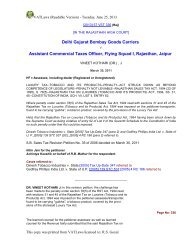


![levy of tax under vat 9b an stamp duty simultaneously[1] - RS Goyal ...](https://img.yumpu.com/45559052/1/158x260/levy-of-tax-under-vat-9b-an-stamp-duty-simultaneously1-rs-goyal-.jpg?quality=85)
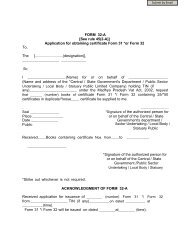
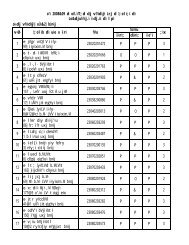
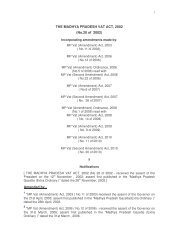


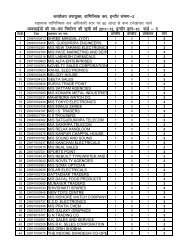
![[2012] 54 VST 26 (P and H) - RS Goyal & Associates](https://img.yumpu.com/38348208/1/190x245/2012-54-vst-26-p-and-h-rs-goyal-associates.jpg?quality=85)

![[2012] 47 vst 116 (cestat) - RS Goyal & Associates](https://img.yumpu.com/38348091/1/190x245/2012-47-vst-116-cestat-rs-goyal-associates.jpg?quality=85)
![[2012] 47 VST 379 (Ker) - RS Goyal & Associates](https://img.yumpu.com/38348087/1/190x245/2012-47-vst-379-ker-rs-goyal-associates.jpg?quality=85)